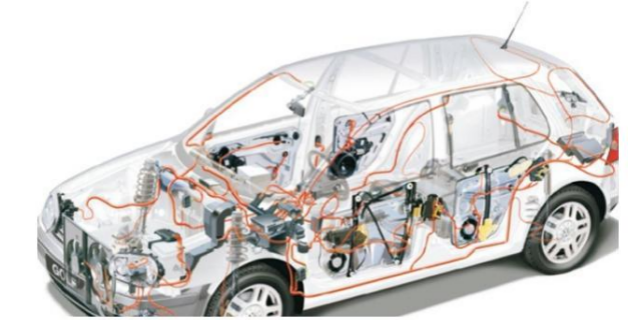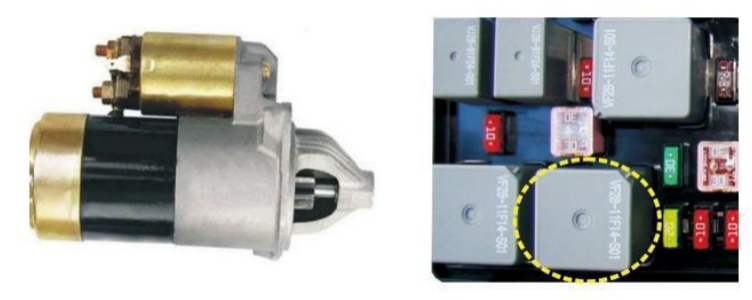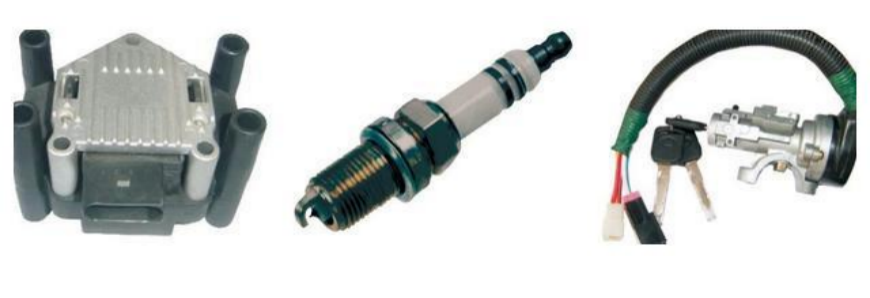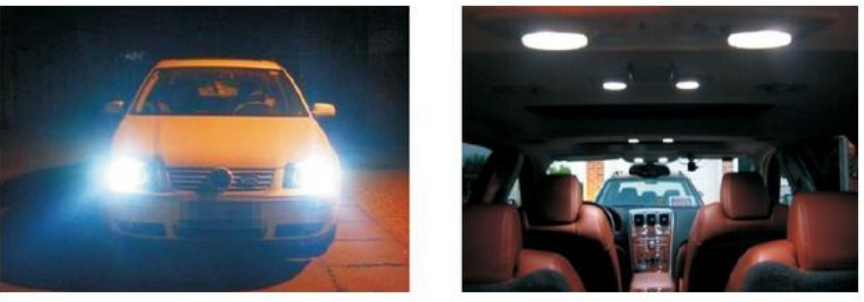
The circuits (or whole vehicle circuit) is based on the automotive electrical system (including the power supply system, starting system, ignition system, lighting and signal system, instrument and alarm system, electronic control unit and auxiliary electrical appliances, etc.) of the working characteristic and the correlation between each system, using equipment such as fuse, switch and wire connection of a whole circuit. Figure as below, shows the distribution of electric components in the Volkswagen Golf.

1. Power system
The power supply system consists of a battery and a alternator. Its function is to provide low voltage direct current energy to the whole vehicle electrical equipment. Power supply from the battery when the engine does not work. After the engine starts, the alternator generates electricity to supply power to the electrical equipment and charge the battery.

2. The starting system
The starting system consists of a starter and a control circuit, which is used to start the engine. As shown in the figures below.

3. Ignition system
Modern electronic gasoline engine ignition system consists of ignition coil, spark plug, ignition switch, etc. The purpose of the ignition system is to generate electric sparks and reliably ignite the combustible mixture in the cylinder. As shown in the figures below(main components of ignition system).

4. Lighting and signal system
The lighting system is divided into interior lighting and exterior lighting. Interior lighting is used to meet the need of interior lighting for drivers and passengers, and exterior lighting is used to ensure the safety of vehicles driving at night, rain and fog. The function of signal system is to announce pedestrians and vehicles to attract attention, indicate the position and running status of vehicles, etc., aiming to improve the safety of vehicles. Interior lighting and exterior lighting as shown in the figures below.

Instrument and alarm system
The instrument and alarm system mainly consists of a combination of instruments (including fuel meter, water temperature meter gauge, speedometer, engine tachometer, etc., as shown in Figure below, sensors, various alarm indicators and controllers. Its function is to provide the driver with various parameters and abnormal conditions of the car to ensure the normal working of the car.

6. Electronic control device
The electronic control device is composed of electronic fuel injection system, electronic ignition system, automatic transmission, anti-lock braking system (ABS), electric steering system, electronic control suspension system, air conditioning system, anti-theft system, etc. The electronic control device controls each system to operate under the optimal condition, which improves the power performance, economy, safety and comfort of the vehicle.
7. The auxiliary electrical appliances
In order to improve the safety and comfort of vehicles, many auxiliary appliances, such as windscreen wipers, electric rear view mirrors, electric windows, electric sunroof, electric seats and other devices are commonly used in vehicles at present. The common auxiliary appliances are shown.
Characteristics of automobile electrical system
Automobile circuit is the same as the general circuit, the circuit is in series, parallel or mixed mode between the electrical appliances. It has three basic working states: current path, open circuit and short circuit. Each electric appliance in circuit diagram adopts special symbol or diagram frame with annotation text. But the automobile circuit has some characteristics of its own.
1. Low voltage power supply
The rated voltage of automobile electrical system is mainly 12V and 24V. Gasoline cars generally use 12V power supply, diesel cars mostly use 24V power supply (composed of two 12V batteries in series), the future car may use 42V power supply system.
2. DC power supply
This is mainly from the battery charging point of view to consider, modern car engine is started by electric starter, starter is powered by the battery. However, charging the battery must use Dc power supply, so the automobile electrical system is the DC system. The direct current of the automobile is the alternating current, generated by the alternator and rectified by the rectifier inside the alternator. The voltage regulator adjusts the voltage and then outputs it.
3. Use two power sources
The car uses two power sources, the battery and the alternator, which supply power to the electrical equipment in parallel. The battery is an auxiliary power supply. When the alternator does not generate electricity or the voltage is low (lower than the terminal voltage of the battery), the battery supplies power to the electric equipment, and the alternator is the main power source. When the engine runs at a certain speed, the alternator starts to supply power to the electrical equipment on the car, and at the same time, it charges the battery to replenish the electricity lost by the battery.
4. Safety device installed
In order to prevent wiring harness and electrical equipment from burning out due to ground or short circuit, automobile circuits are installed with safety devices to prevent overcurrent, such as fuse, fusible wire, etc. If the circuit appears overcurrent, these safety devices will be disconnected before wiring harness and electrical equipment is damaged.
5. Parallel connection of electrical equipment
Each electric equipment of the automobile adopts parallel connection, and each electric equipment is controlled by a special switch in series in its branch, without interfering with each other. When repairing automobile circuit, it is convenient to disassemble and install some electric equipment without affecting other electric equipment.
6. Adopt single wire system
Single line connection is the biggest characteristic of automobile circuit. Automobile electrical appliances are all connected in parallel, theoretically requiring a common live line and a common neutral line. The car engine and chassis are made of metal and have good electrical conductivity. Therefore, the use of the car's metal body as a variety of electrical equipment as the common wire, and electrical equipment to the power supply just need to use a wire connection, so called single-wire system.
Using single wire system can save wire, make the circuit simple, easy to install and repair, therefore, modern cars are basically using single wire system.
7. Negative ground
An electrode of the battery is connected to the frame or body of the car when adopting single wire system, commonly known as "Negative ground". The battery's positive terminal connecting frame or body is called positive ground.Negative ground has less interference to radio equipment (audio, communication system), less electrochemical corrosion to the frame and the body, and has the advantages of strong connection. At present, most of the cars use the negative ground in the world.
8. Automobile circuits are composed of unit circuits
Although automobile circuits are complex, they are composed of relatively independent unit circuits with different functions. If you read each unit circuit carefully, you will be able to read the whole car circuit.
9. Car circuits have color and identification features
The number of automobile wire is many, in order to facilitate identification and maintenance of automobile electrical appliances, the low voltage line in the automobile circuit usually use different colors of wire, the color letter codes to mark out in the automobile circuit diagram. The color code of different car wire is also different.
 James Smith
James Smith  November 09, 2020
November 09, 2020